In brief: This post explains what a derecho is, where the term came from, and talks a bit about some past thunderstorms of note in Houston.
What is a derecho?
The National Weather Service has concluded that Thursday’s severe storms in Houston constituted a derecho. So what does that mean?
First off, it’s pronounced “deh-REY-cho.” Meteorologists have debated what the definition of one of these things actually is for years. And we still don’t have a concrete, universally accepted definition. However, progress was made after a 2011 storm that hit the Southeast and a 2012 derecho that ravaged the Mid-Atlantic and Midwest to work toward something more widely accepted. Ultimately, NOAA/NWS defines a derecho as a continuous or intermittent path of wind damage from a squall line of thunderstorms, bow echo, or quasi-linear convective system (QLCS) that extends at least 400 miles and is at least 60 miles wide. In other words: It’s a swath of wind damage from mostly non-tornadic thunderstorms that extends for 400+ miles and is at least 60 miles wide.
What makes it different than typical severe thunderstorms?
A derecho, as noted above can be a squall line, bow echo, or QLCS. We get several of those types of events every year in Houston. What sets a derecho apart is the wind damage. It’s not normal. It’s not a couple trees on power lines. It’s a lot of wind damage over a long path.
Are all derechos the same?
No! Derecho events are broken down into three categories: Serial, progressive, and hybrid. A serial derecho is basically where you have one giant squall line that is hundreds of miles long with multiple embedded bow echoes producing widespread wind damage. A progressive derecho is the one we experienced in Houston last week that is typically no more than about 250 miles wide. You also have hybrid outcomes, which basically share characteristics of the two others.
Why is it called a derecho?
According to NOAA, Dr. Gustavus Hinrichs, who was a professor at the University of Iowa coined the term in 1888. The literal Spanish translation of derecho is “straight ahead” or “direct” or even “right.” Here’s where the etymology gets kind of fun. “Tornado” derives from the Spanish “tronada,” which literally means thunderstorm. But there is also a Spanish word “tornado” which essentially means “twisted,” and it derives from the Spanish verb “tornar,” which means “to twist.” So essentially, Hinrichs took the “opposite” of twisted and decided that derecho (or “straight”) would be a good way to distinguish tornado-like wind damage that was not caused by a tornado.
Are derechos common?
The short answer is: Kind of. The most recent derecho prior to Thursday’s in Houston occurred back on April 1-2 from just west of Missouri through West Virginia. A storm that almost met derecho criteria occurred just this past weekend in Kansas and Missouri. There were derechos in 2023, 2022 in Canada, 2021, and so on. In fact, the quad-state area around Kansas, Missouri, Arkansas, and Oklahoma northeast of Tulsa averages more than one derecho per year.
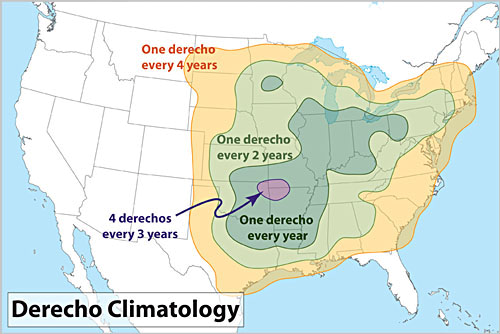
Derechos are most common in May, June, and July. Keep in mind that a lot of the areas that see derechos every 1 to 2 years are more rural, so it’s likely you hear less about them than when they hit places like Chicago or DC or Houston directly, causing billions in damage.
You can read about a bunch of pre-2012 events across the country here. Some even occur out West. I was introduced to derechos when I worked in Upstate New York early in my career. The memories of the 1998 Syracuse derecho were still incredibly sharp, much like Houstonians will remember last week’s. That was followed up by a second derecho event that moved from Michigan to New York City. The 1995 Adirondack derecho (or Adirondack blowdown) was responsible for knocking over more than half the trees in 100,000 acres of Adirondack Park.
The Houston area’s history with derechos and thunderstorm wind events
There are a few thunderstorm wind events and derechos that have stood the test of time in this area. First and foremost was just last summer when a squall line delivered a 97 mph wind gust to Bush Airport.
That storm on June 21st was one in a series last June that caused damage across the area. It was not a derecho, but it certainly caused severe damage north of downtown Houston.
A storm system in 2002 did a good bit of damage, including to the I-10/Gessner area, according to the Houston Chronicle’s archives. Just shy of $1 million in damage was reported with fortunately no injuries.
In early May 1993, a powerful squall line knocked out power to 200,000 homes in Harris County and went on to rampage Galveston County, causing at least $50 million in damage and delivering a 98 mph wind gust to Scholes Field in Galveston.
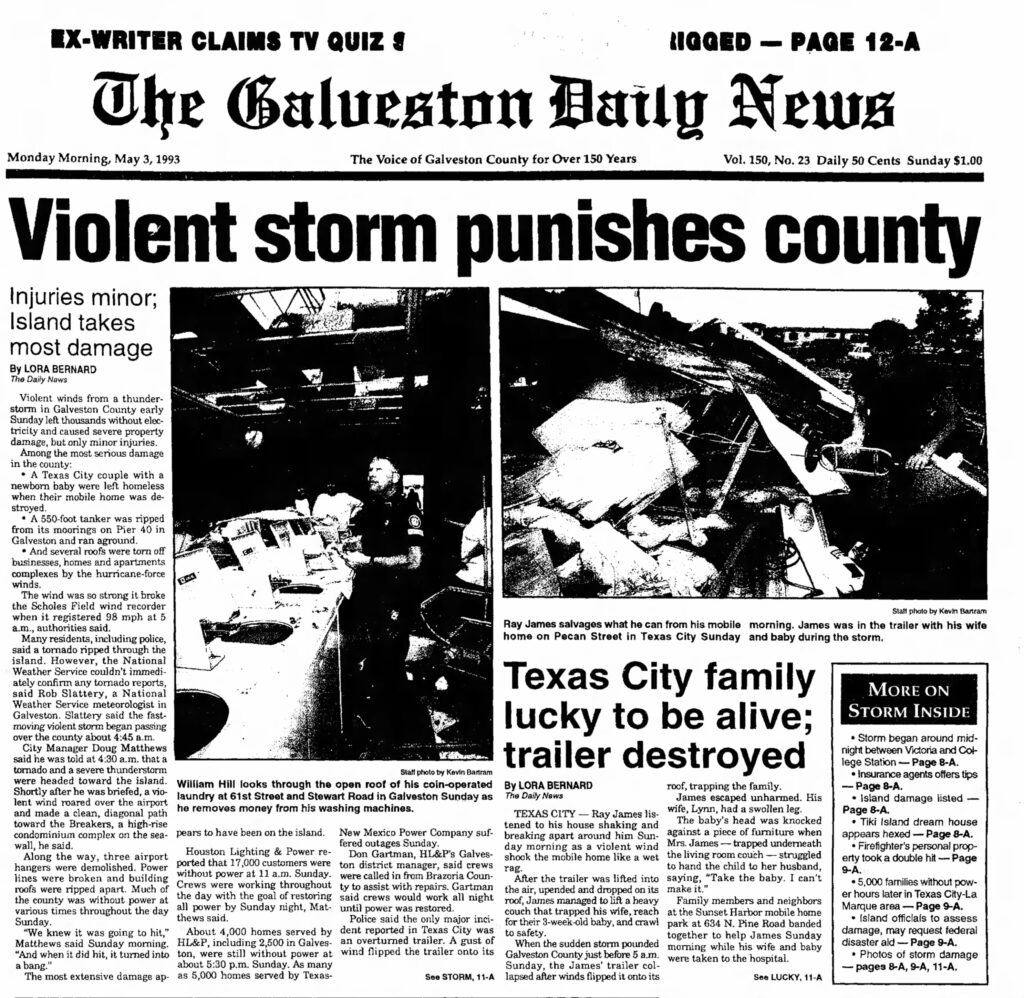
There was also an event the year after this in March that brought 100 mph winds to the less populous western end of Galveston Island.
Texas Boaters’ Derecho (May 1986)
While not Houston, the “Texas Boaters’ Derecho” of May 1986 makes the list of memorable derecho events in the United States. You can read a full summary of the event on page 20 of the May 1986 NOAA StormData publication.
It’s tough to find a lot of good information on how this particular event impacted Houston specifically, but it is infamous due to the fact that it drowned six. There was a fishing tournament and boat race on Lake Livingston that day when the storm hit, bringing winds estimated to be 90 mph and waves of 10 feet on the lake. Much like we see with the damage from this year’s derecho, there were pockets of more significant damage within a broad damage field during the 1986 storm.
May 1983 storms
Thanks to Bill Read for pointing this one out to us last week. Three years prior to the ’86 derecho, a particularly bad thunderstorm event impacted much of the Houston area.
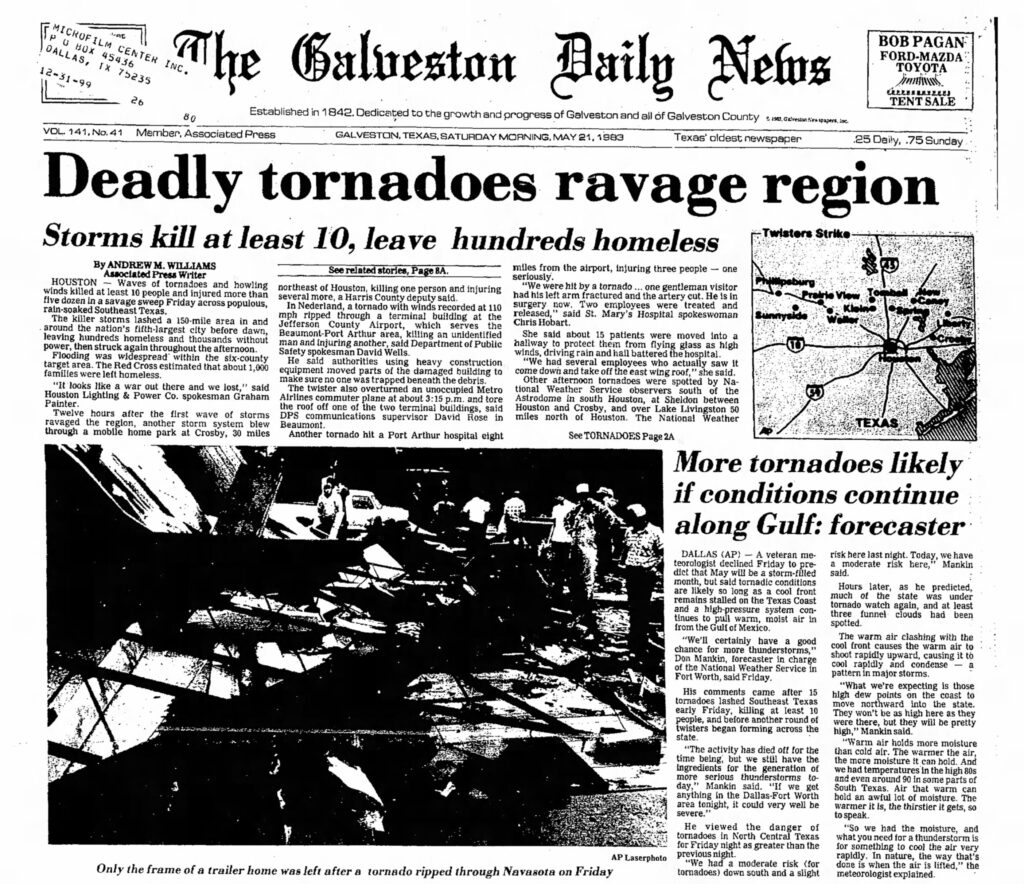
According to NOAA’s May 1983 StormData, approximately four downburst events, including one over the city of Houston, combined with eight tornadoes for a deadly severe outbreak in our area. Winds were estimated at 75 mph or stronger in spots, with several transmission towers crumpled over, much like in this month’s event.
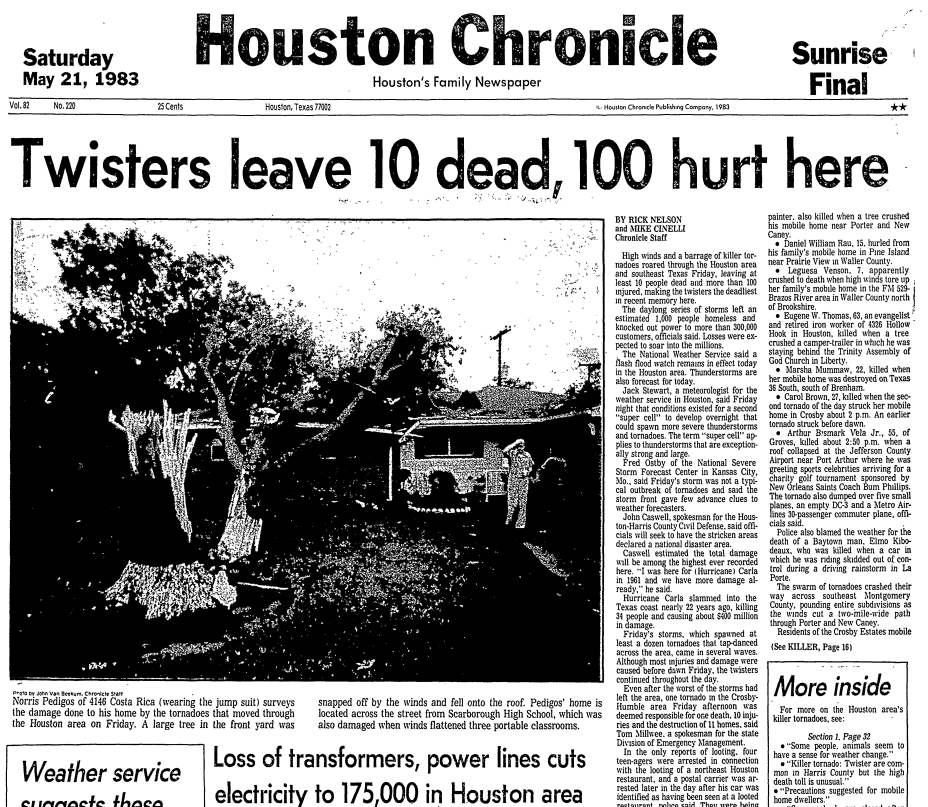
Over 300,000 customers were left without power in that storm, which would have been a bit less proportionally to this year’s storm. Winds were measured as strong as 110 mph during a tornado in Nederland, near Beaumont with this one. According to a Houston Chronicle recap of this event at the time, the spokesman for the Houston-Harris County Civil Defense stated that the damage was worse than in Hurricane Carla in 1961.
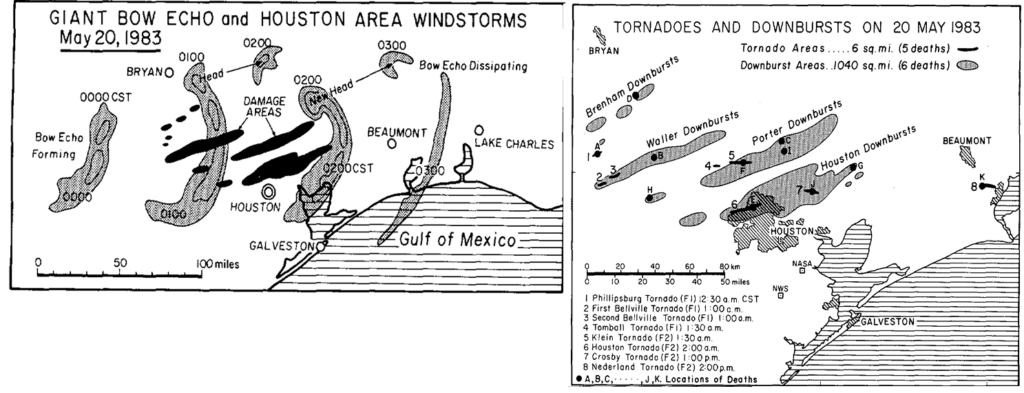
Approximately 10 people died with over 100 injured from this storm. Arguably, this was the previous worst non-hurricane wind storm in Houston until last week’s. It’s tough to find an official estimate on the damage caused by the May 1983 event, but it was likely in the tens of millions of dollars at the time.
Other events that seemed to garner some attention were a combination of severe storms and tornadoes on May 2, 1979, which primarily impacted western and northwestern parts of the area. On May 7 of 1976, significant wind damage occurred east and southeast of Houston, along with a few tornadoes nearby. The Exxon facility in Baytown apparently observed winds of 90 to 95 mph with considerable damage in that community. Back on June 4, 1962, a torrential squall line of storms seems to have had something of a similar impact on parts of the city as the recent derecho. Many people lost power, wind gusts hit at least 75 mph, and some windows were blown out downtown.
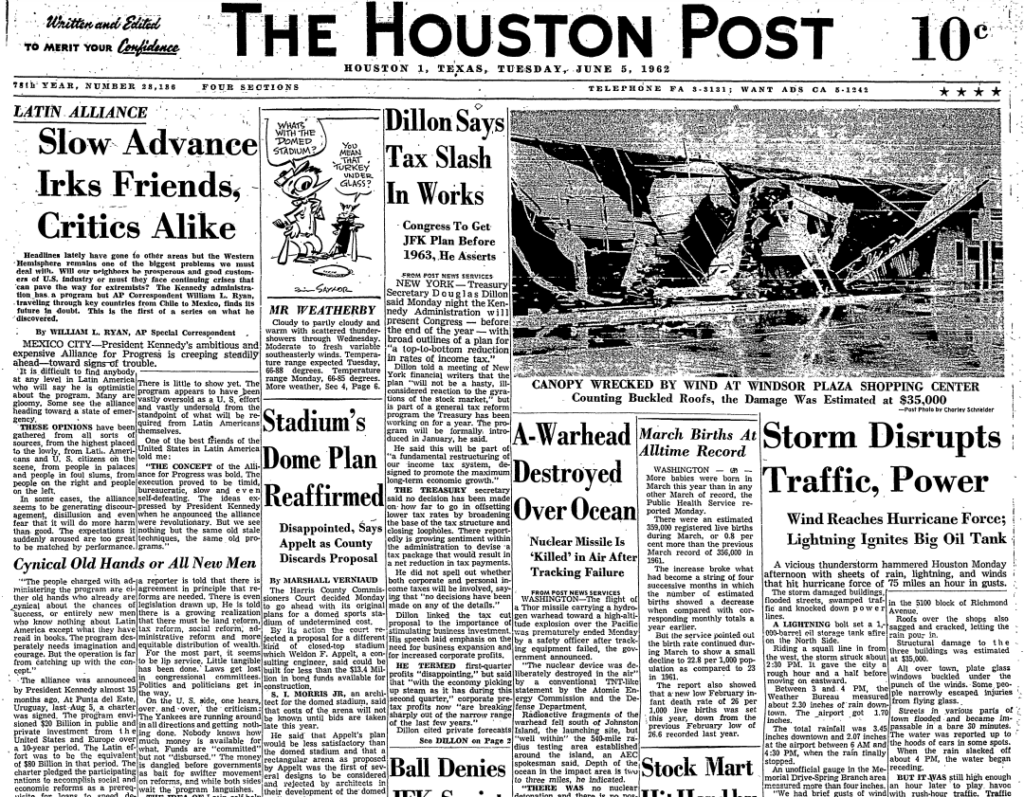
While last week’s derecho was extreme by any real definition of Houston thunderstorms, I think we can assume that perhaps the return period on such a storm may be less than we might have thought. And Houston can now add destructive thunderstorm winds to a litany of periodic weather disasters including freezes, floods, hurricanes, extreme heat, and drought.

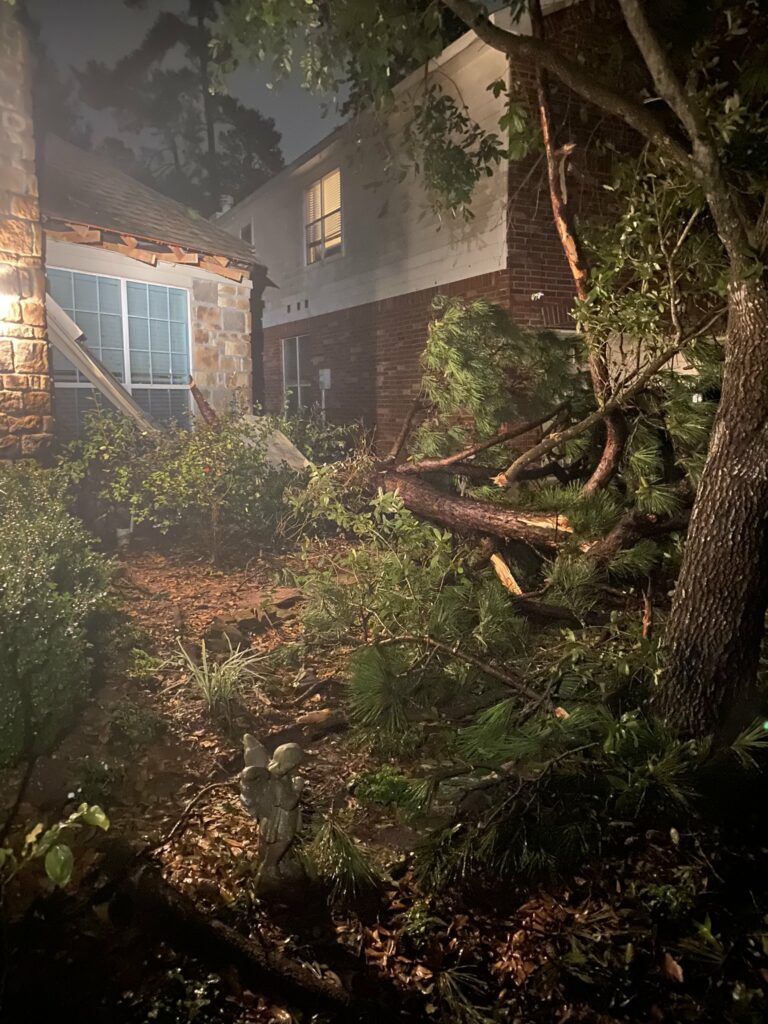
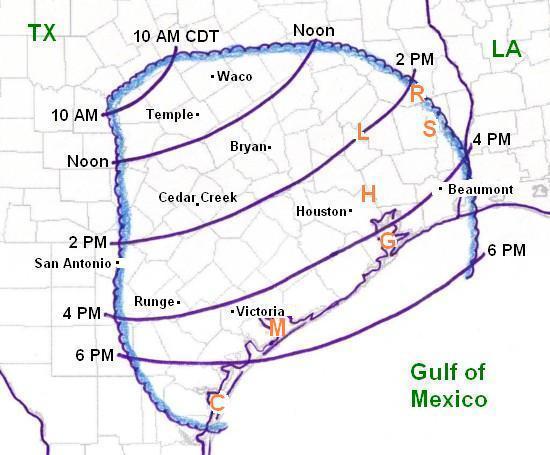
Thank you for a very interesting post. I’d like some supplementary info on how these things form, ie the atmospheric physics, if it can be explained in relatively simple language. I think I remember (maybe from a previous post here?) that this was essentially a case of upper level winds dipping close to the ground. Is that correct? If not what does happen? If so, can you expand on that a little bit?
Fairly deep dive here: spc dot noaa dot gov/misc/AbtDerechos/derechofacts dot htm
This is all very interesting but the Houston Post bit about the “domed stadium” was a real treat.
This is very interesting. I love the way you guys take time to break down unusual events for us. Weather is becoming more intense the information you supply is something I would have never really cared about but you guys make it interesting and informative for us amateurs. Keep up the wonderful work. We appreciate you!!!!!
Thanks for all the info. I enjoyed learning about the meaning of derecho. I’m curious – why do we use Spanish words for weather – la nina, el nino, derecho….? I don’t believe there are English words of the equivalent.
“El Niño” and “La Niña” were named by Spanish-speaking fishermen off the coast of South America. “Derecho” was coined by Dr. Gustavus Hinrichs, a 19th-century scientist in the United States. The term accurately describes the storm’s nature, and there isn’t an equivalent English word that conveys the same meaning.
So.. first if it is derived from the Spanish word derecho is it not pronounced “deh-REY-cho” but rather “deh-reh-choh”. Second.. there are English equivalents. El Nino = The Boy, La Nina = The Girl and Derecho = Straight
Sorry, pulled the pronunciation from here: https://www.spc.noaa.gov/misc/AbtDerechos/derechofaq.htm This is a bit of an older site, so it’s possible they’ve corrected how they reference it now.
I believe tornado is also a Spanish word, twirling wind or something similar.
Sorry, didn’t mean to reply directly to you.
Well, ain’t that something. That’s what I told my wife when I looked at the radar and saw the wind speed reports as the storm was entering the greater Houston area. Most people haven’t heard of this type of storm before. Nature is always full of surprises, ain’t she?
Matt/Eric, is anyone scraping through PWS data around Houston to get a better picture of actual wind speeds? My PWS in Timbergrove measured a 115 mph gust (which lines up with the damage). Would be interesting to compile that data and have a higher resolution timeline of events.
Chris, have you provided this to NWS Houston? I imagine they would want to scope out the station and see if it can be validated.
Great information, Matt & Eric 🤗
You are the best 💗 SCW 💗
Excellent explanation and very understandable. Thanks!!
For directions I learned derecha = right and derecho = straight – this maybe Spanish as in Spain.
My wife was visiting family in Cedar Rapids, Iowa in August 2020. She was driving around town when that derecho hit with peak wind gusts of 140 MPH. She was traumatized.
Geez,
6 years of Spanish just went down the drained.
All those years , they taught us : DERECHO translated as “Right”.
I just learned something new.
https://translate.google.com/?sl=es&tl=en&text=derecho&op=translate